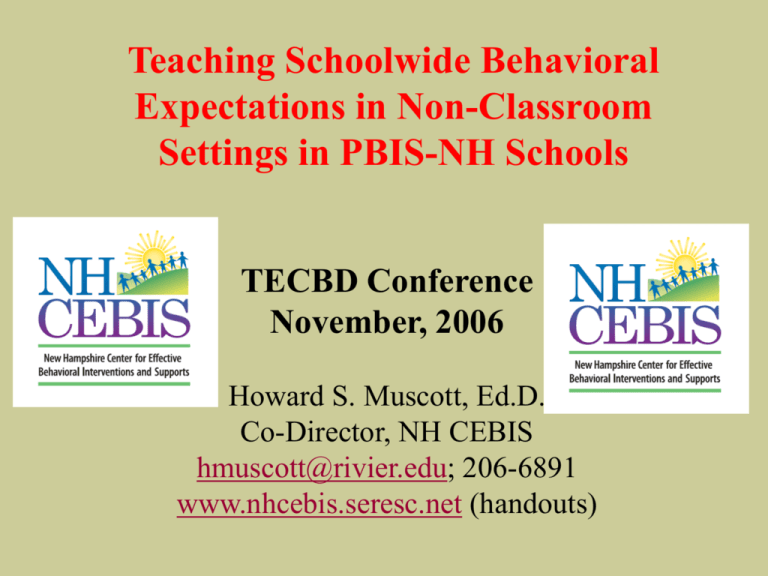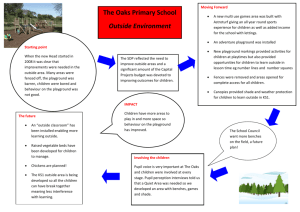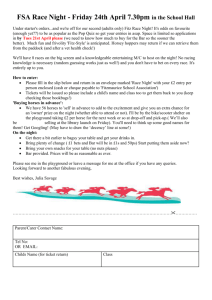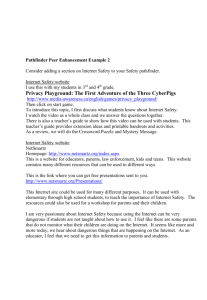Using PBIS on the Playground and Other Non - NH CEBIS
advertisement

Teaching Schoolwide Behavioral Expectations in Non-Classroom Settings in PBIS-NH Schools TECBD Conference November, 2006 Howard S. Muscott, Ed.D. Co-Director, NH CEBIS hmuscott@rivier.edu; 206-6891 www.nhcebis.seresc.net (handouts) To Our PARTNERS, We Thank You! NH Department of Education Virginia Irwin, Robert Wells, Deb Grabill NH Department of Health and Human Joe Perry Services, Bureau of Behavioral Health APEX Initiative JoAnne Malloy Alliance for Community Supports Gail Cormier Granite State Federation of Families Kathleen Abate, Linda Thomas NAMI-NH Michael Cohen Developmental Disabilities Council Alice Porembski SERESC, Inc. Antonio Paradis & Becky Berk Rivier College Charles Mitsakos University of New Hampshire, Keene State College, Plymouth State University Granite State College Mary Ford PBIS Center, University of Oregon George Sugai, Rob Horner Illinois EBD Network Lucille Eber New Hampshire Connections Dawn Marquis Maryland PBIS Susan Barrett Agenda 1. Problem Behavior in Non-Classroom Settings 2. Data-Based Decision Making 3. Features of Supervision on the Playground 1. 2. Move, Scan, Interact Focus on Active Supervision 4. Supervision Self-Assessment Scale School-wide Positive Behavior Support Systems Classroom Setting Systems School-wide Systems PBIS Big Idea Problem behavior in non-classroom settings (hallways, cafeteria, playground, common areas) accounts for 50% of all problem behavior in schools. Source: Colvin, Sugai, Good, & Lee (1997) Non-Classroom Settings Common Areas Transitions Hallways Playground Recess 50% of all problem behavior in school Cafeteria Buses Nonclassroom Settings Adapted from Sugai & Colvin, 1996 Particular times or places where supervision is emphasized Cafeteria, hallways, playgrounds, bathrooms Buses & bus loading zones, parking lots Study halls, library, “free time” Assemblies, sporting events, dances Where instruction is not typically available Where ratio of adults to students is typically lower than in classrooms (lightly staffed) Where supervision is typically shared or staffed by non-certified staff Decision-Making and Problem-Solving is Thoughtful and Calculated (Mann & Muscott, 2005) Utilize an action-oriented decision-making system that can apply to all levels of behavior Begin with Outcomes (What do we want to achieve?) or Key Questions (What do we want to know?) Identify the scope a Problem (scope and context) through the use of Data (Where we are now?) Identify Action items to get to the outcomes (What do we want to do?) (Strategic Plan) which creates Structure so that follow through is an expectation Monitor and Evaluate progress – Use Data to assess your progress (Did it work?) Adapted from Horner (2003) Goals of Playground Supervision 1. 2. 3. 4. 5. To provide an opportunity for physical exercise, social development, and fun To keep students safe To provide an opportunity for students to learn and engage in appropriate playground behavior that increases the likelihood it will occur in the future To get students on and off the playground in an efficient and effective manner and back to class ready to learn To respond to problem behavior in a way that decreases the likelihood it will occur in the future PBIS-NH Supervision on the Playground: Activity 1 1. What do you want to achieve on your playground during recess next year? 2. What do you want to know? 3. How will you know if you have achieved success? Data from PBIS-NH Schools 2003-04 PBIS-NH elementary schools show playground as second most common area for problem behavior after classroom. PBIS-NH middle schools show hallways as second most common area for problem behavior after classroom. PBIS-NH high schools show hallways and office as tied for second most common areas for problem behavior after classroom. PBIS-NH multi-level schools show hallways , playground and cafeteria as tied for second most common area for problem behavior after classroom. Tag Gone Bad! Thorntons Ferry Elementary School Playground was the location where most of the ODR referrals come from Aggression/Fighting was the biggest problem behavior by far Referrals were coming from many students rather than a few SWIS data revealed highest levels of problem behavior was coming from 1st and 2nd graders on the playground at recess (214 ODRs August 03 through May 10, 2004) Observation and reflection discerned it was primarily “tag gone bad” or lack of skills and appropriate games Reducing Aggression on the Playground Thorntons Ferry Elementary School 8/01/03 – 5/10/04 8/01/04 – 5/10/05 Thorntons Ferry ES Merrimack NH September 2004 vs. September 2003 SWIS Data adjusted for number of students Physical Contact 11 per 100 reduced to 6 (46%) Defiance/Disrespect/Noncompliance 18 per 100 reduced to 5 (73%) Why the Improvement? Focused on teaching the playground expectations rather than punishment Universal Team taught playground monitors active supervision Universal Team developed and taught the monitors and children Rules and Games for the Playground Classroom teachers pre-corrected students by reminding students of expectations before leaving their classrooms each day for recess PBIS-NH Supervision on the Playground: Activity 2 1. 2. 3. 4. 5. 6. Identify any data source you have for playground/ recess behavior for the 2005-06 school year. How many instances of problem behavior are there? (year, average per day, etc.) What types of problem behaviors are more prevalent? Are there patterns for who exhibits the most problem behavior? (grades, individual students, gender) Are there certain times when more problem behavior occurs? Are there certain activities or games where more problem behavior occur? (dodgeball, 4-square, tag, swings, etc.) Do You Need to Gather More Information? An observation is planned for recess What should we be looking for? Interviews with the supervising staff are planned What should we be asking them? More SWIS reports are available Which ones should we generate? Features of Effective Behavior Support in Nonclassroom Settings 1. 2. 3. Environmental Arrangements Teaching Routines and Activities based on Expectations from the Teaching Matrix Active Monitoring and Supervision by adults 1. 2. 3. Move Scan Interact Positive Contacts 2. Positive Acknowledgements 3. Precorrections 4. Corrections for rule violations Self-Assessment 1. 4. 1. Environmental Arrangements 1. Create visuals and other arrangements to support expected behavior 1. 2. 3. 4. 5. 6. Behavior Matrix for location posted Posted rules that go beyond the matrix on equipment Painted lines to line up Green light on right side of hallway Posters with procedure for lunch line Storage spaces for equipment with visual cues Playground Expectations Amherst Street Elementary School Playground Follow adult directions Be a good sport Use kind words Play fair Follow Use your playground Pledge equipment Return properly everything Report unsafe you behavior borrowed Stay in the Walk playground quietly into area the building PBIS-NH Supervision on the Playground: Activity 3 Review your playground/recess environment to determine whether physical arrangements support your program and develop an action plan for addressing any that are lacking? 1. 1. 2. 3. 4. Is the Behavior Matrix posted so students and faculty can see it? Is there a need to posted rules or procedures that go beyond the matrix on or nearby specific equipment or activity areas? Are there visual supports such as painted lines to help with procedures like lining up, playground boundaries, or a safety line for standing near swings? Are there storage spaces for equipment with visual cues that help students keep equipment such as balls, jump ropes, etc. organized? 2. Teaching Expectations from Matrix for Routines and Activities 1. Transition Routines 1. 2. 3. 4. 2. Activity Routines 1. 2. 3. Lining Up Entering and exiting Putting materials away Signal for attention Games Activities (Get food, take out a book, etc.) Special Routines 1. 2. 3. Bus evacuation Applause Emergencies Schoolwide Outcomes Schoolwide Teaching Team Data-Based Decision Making Schoolwide Recognizing Assessing Effectiveness PBIS-NH Supervision on the Playground: Activity 4 1. 2. 3. 4. 5. Review your teaching matrix for the key expected playground/recess behaviors? Does it include positive behaviors that are replacements for the problem behaviors identified by your data as most significant? If so, identify the specific behaviors that should be highlighted in the teaching rollout. If not, create replacement behaviors that address those problem behaviors, adapt your teaching matrix and get it ratified by the universal team and faculty. Design a teaching rollout for playground following PBIS-NH guidelines. 3. Active Supervision by Adults Active supervision is a critical yet under-utilized skill by adults in nonclassroom settings Involves 3 sub-skills: Scan, Move, Interact Scan: Visually examine the entire environment frequently noticing both appropriate and problem behavior Move: Physically move around the entire area in an unpredictable pattern while visiting the problem areas frequently Interact: Elicit conversations with most of the students while providing precorrections and reminders as well as positive recognition Tips for Scanning Be Constant and Strategic Scanning Should Be Constant Constantly scan the environment with both your eyes and ears by looking at each area for a few seconds Look at the big picture frequently Look at student behavior specifically Scanning Should Be Strategic Practice identifying actions and sounds that signal problems Learn to recognize signs that precede problem behavior Students with sad or scared facial expressions or concerned looks Games breaking up for no apparent reason Quick violent movements Tips for Movement Be Constant, Random and Strategic Movement Should be Constant Constantly move around to all areas of the playground or those you have responsibility to supervise Movement Should be Random Movement patterns should be unpredictable so that students can’t gauge when you will be in an area Movement should be Strategic Identify trouble spots on playground and move to them more frequently Identify students or combinations of students who engage in either more problem behavior or more behaviors that are likely to result in more conflicts and visit them more frequently Tips for Interacting with Students Be Positive, Specific and Brief Interactions Should Be Positive Provide positive contacts Provide positive recognition Provide frequent recognition for students exhibiting expected behaviors Interactions Should Be Specific Use specific language from the teaching matrix when recognizing students Use precorrections to support positive behavior Focus on student behavior, not individual students Interactions Should Be Brief Keep interactions short and to the point so that you can interact with most students during the period Continue to visually scan the environment during interactions Provide Positive Contacts Smith & Sprague (2004) Be friendly and helpful in general Constantly smile and wave at students as you move and scan Be proactive Provide at high rate Short in duration (5-10 seconds) Non-conditional for specific behaviors Delivered mostly to groups not individuals Positively Recognize Expected Behaviors Provide specific, verbal recognition using words from the teaching matrix Provide recognition at a 4:1 ratio or better of positive to corrective contacts Provide a recognition as quickly after the expected behavior as possible Focus positive attention on problem routines Recognition as many students as possible Provide additional recognition based on your schoolwide plan Recognition Systems Muscott & Mann (2006) Step 1: Specific verbal praise paired with visible acknowledgement given at high rates. Step 2: Specific verbal praise paired with visible acknowledgement given intermittently. Step 3: On-going random verbal praise connected to broad expectations and designed to enhance climate and Highly visible periodic “attention grabbing: celebrations of success SW Recognition Planning Matrix Muscott & Mann (2006) In which strategic location will the behaviors be recognized? What specific behaviors will be recognized in that location? What is the visible acknowledgement? How often should it be given? Who will be recognizing the students? When should the recognition start? When should the next step begin? What, if anything, happens to the visible recognition after it is earned? 9. How will we ensure that staff practice giving out recognition prior to implementation? 10. How will we know staff is implementing according to the plan? 11. Are there any special circumstances? 1. 2. 3. 4. 5. 6. 7. 8. Use Precorrections to Support Positive Behavior Quick reminders of expected behaviors that occur prior to the expected behavior Group or Individual Focus on key errors to pre-alert students Only one line leader please 5 minute reminder prior to the end of recess Go up the ladder on the slide only Use visuals and concrete examples in addition or verbal reminders Responding to Problem Behavior: Consequences or Corrections for Minor Rule Violations Follow schoolwide procedures Handle minor rule violations quickly, quietly, neutrally, and with positive follow-up Respectful, non-critical, non-argumentative Resolve privately if possible Focus on behavior, not student Use 2-minute rule – If the issue cannot be resolved in 2-minutes, refer to support staff or follow school procedure Responding to Problem Behavior: Consequences or Corrections for Major Rule Violations Follow school procedures for major rule violations Be businesslike, neutral, disengage Resolve privately if possible Focus on behavior, not student Follow 2-minute rule, refer or get help If successfully resolved, acknowledge student Precorrect for next time Follow group and individual plans when they exist Supervision Self-Assessment Scale Sugai & Colvin, 2004 Informal self assessment regarding critical features of non-classroom management with action plan Available on www.pbis.org website Features of Active Supervision for Playground Monitors Muscott (2006) 1. 2. 3. 4. 5. Playground monitors know the schoolwide and playground expectations and can state them. Playground monitors contribute to the teaching of playground expectations to students in rollout or booster activities. Playground monitors contribute to the teaching of the safe use of equipment to students in rollout or booster activities. Playground monitors help new students learn the playground expectations and safe use of equipment. Playground monitors move continuously and unpredictably throughout area making their movements obvious, positive, and interactive. Features of Active Supervision for Playground Monitors Muscott (2006) Playground monitors scan the playground frequently with your head up, maintaining eye contact and with an overt body position. 7. Playground monitors engage in frequent and varied positive interactions with most of the children on the playground. These quick, noticeable, public and developmentally appropriate interactions should include social positives and schoolwide acknowledgements. They should be individualized, informative, and sincere. 8. Playground monitors provide at least 4 positive for each negative student contact. 9. Playground monitors handle minor rule violations quickly, privately, neutrally, then follow-up with a positive interaction. 10. Playground monitors handle major violations quickly, by the book using school procedure, and in a business-like manner. They disengage quickly and precorrect for the next occurrence if possible. 6. PBIS-NH Supervision on the Playground: Activity 5 1. 2. If you have supervisory responsibilities on the playground or other non-classroom environment, rate yourself on the Supervision Self-Assessment Scale and identify areas in need of further skill development. If you don’t list the people who have supervisory responsibility on the playground and develop an action planning for how you might proceed to help them gain the knowledge and skills of systematic supervision.


